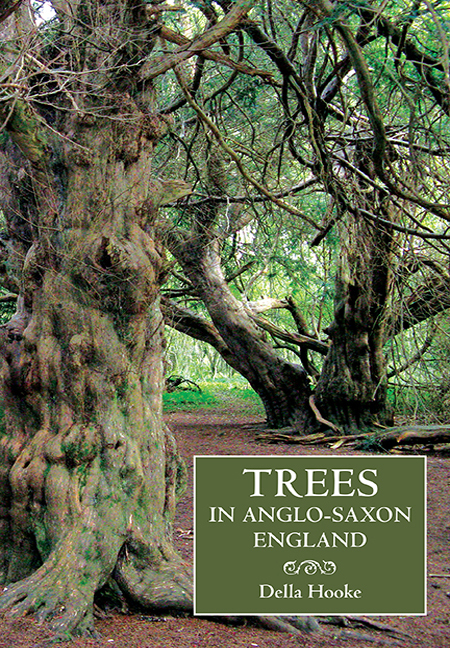Book contents
- Frontmatter
- Contents
- List of Illustrations and Tables
- Preface and Acknowledgements
- List of Abbreviations
- PART I Tree Symbolism
- PART II Trees and Woodland in the Anglo-Saxon Landscape
- PART III Individual Tree Species in Anglo-Saxon England
- Chapter 8 Trees of Wood-Pasture and ‘Ancient Countryside’
- Chapter 9 Trees of Wet Places in Early Medieval Records: Alder and Willow
- Chapter 10 Trees of Open or Planned Countryside
- Chapter 11 Other Trees Noted in Charters and Early Place-Names
- Chapter 12 Trees not Readily Apparent in the Early Medieval Written Record
- Epilogue
- Bibliography
- Index
- Anglo-Saxon Studies
Chapter 9 - Trees of Wet Places in Early Medieval Records: Alder and Willow
from PART III - Individual Tree Species in Anglo-Saxon England
Published online by Cambridge University Press: 09 May 2017
- Frontmatter
- Contents
- List of Illustrations and Tables
- Preface and Acknowledgements
- List of Abbreviations
- PART I Tree Symbolism
- PART II Trees and Woodland in the Anglo-Saxon Landscape
- PART III Individual Tree Species in Anglo-Saxon England
- Chapter 8 Trees of Wood-Pasture and ‘Ancient Countryside’
- Chapter 9 Trees of Wet Places in Early Medieval Records: Alder and Willow
- Chapter 10 Trees of Open or Planned Countryside
- Chapter 11 Other Trees Noted in Charters and Early Place-Names
- Chapter 12 Trees not Readily Apparent in the Early Medieval Written Record
- Epilogue
- Bibliography
- Index
- Anglo-Saxon Studies
Summary
There were large areas of undrained land in Anglo-Saxon England. The underground drains of later historical times were, of course, not available and arable land probably already relied heavily upon ridge and furrow ploughing to remove surplus rain-water. Undoubtedly there were also deliberately cut ditches to alleviate flooding but the many references to marsh and fen in charter boundary clauses clearly indicate the presence of scattered patches of ill-drained land throughout most of the countryside. Extensive fenlands such as those around the Wash in eastern England were not to be drained on a large scale for many centuries and the Somerset Levels were particularly extensive until reclamation was undertaken by ecclesiastical landowners in the thirteenth century; patches of marshland like the Weald Moors of Shropshire, previously used as seasonal pasture, only yielded to agricultural improvement after the mid-sixteenth century. Many ill-drained areas like Otmoor in Oxfordshire had to wait until the enclosure movement of the eighteenth and nineteenth centuries before they were drained for farmland. In Worcestershire, pre-Conquest charters reveal the presence of many areas of marshland, some extensive, some less so: byligan fen ‘the ?bag-shaped fen’, for instance, was a low-lying area of marshy land at the head of the Whitsun Brook in the heart of the county, and Longdon marsh was once much extensive on the low plain below the Malvern Hills. In Cornwall the little estate of Lamorran at the head of an inlet near Truro on the south coast was almost completely bounded by streams and marshes.
In addition, floodplains were valued for their hay crop, itself dependent upon the annual floodwaters that encouraged the growth of grass in the spring. Many species of tree flourished in damp conditions, most notably the alder and willow. Even today, alderwoods are a feature of stream and river banks in valleys and on damp spring-fed slopes – wherever water is running and not stagnant – and willows are distinctive features of the landscape, especially along water meadows.
THE ALDER
The alder, Alnus glutinosa, sometimes known as ‘the aller’ (OE alor) is not a long-lived tree, seldom surviving more than 150 years unless pollarded, but readily grows from seed carried along by flowing water. It may reach a height of about 19m.
- Type
- Chapter
- Information
- Trees in Anglo-Saxon EnglandLiterature, Lore and Landscape, pp. 222 - 231Publisher: Boydell & BrewerPrint publication year: 2011

